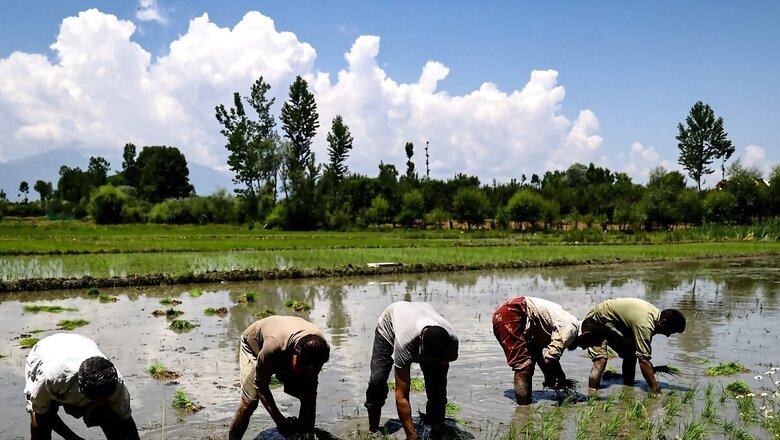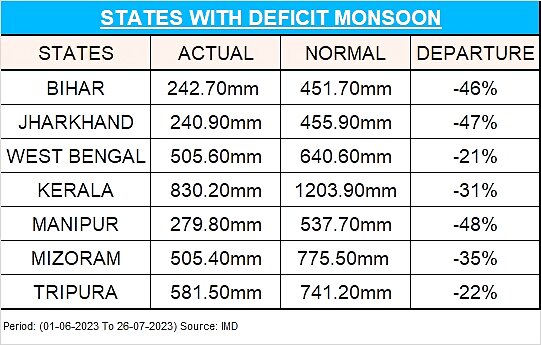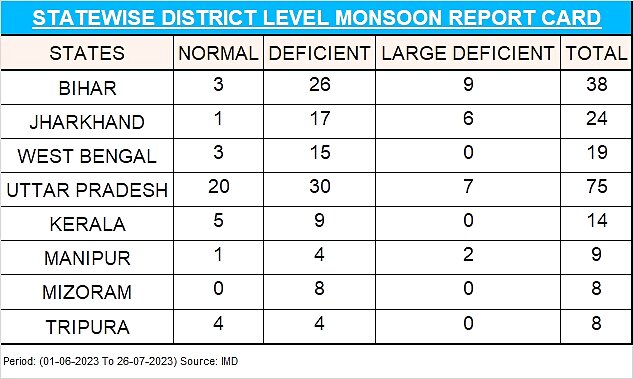Monsoon Discontent: One-Third of India May Face A Dry Season Despite Excessive Rainfall in Northwest

views
Parts of India’s east and south are staring at a drought-like situation this monsoon season even though torrential rains have lashed most parts of north and west India.
The South-West monsoon covered the entire country by July 2 this year but even after three weeks, 32 per cent of the 717 districts tracked by the Indian Meteorological Department (IMD) are witnessing deficient to large deficient rainfall.
Jharkhand, Bihar, West Bengal, Kerala, Manipur, Mizoram, and Tripura are the worst-affected states suffering the monsoon’s discontent.

As of Wednesday (June 26), Jharkhand has a 47 per cent rain deficit, Bihar has 46 per cent shortage, while Kerala and West Bengal received 31 per cent and 21 per cent less rain respectively than expected during this season (01-06-2023 to 26-07-2023).
In the Northeast, Manipur has received only 52 per cent of the seasonal precipitation, while Mizoram and Tripura are experiencing shortages of 35 per cent and 22 per cent, respectively, according to the IMD monsoon bulletin.
When the realised rainfall is -19 per cent to +19 per cent of the long-period average (LPA), it is defined as normal, while rainfall between -59 per cent to -20 per cent and -99 per cent to -60 per cent of LPA is categorised as deficient and large deficient respectively, according to India’s principal national weather forecasting agency.
The situation is especially concerning as these rain shortfall states also serve as the rice bowls of the nation and are in the midst of the critical paddy sowing season.
The IMD data, as on July 26, shows that while 245 or 34 per cent of the 717 tracked districts received ‘normal’ rainfall this season, 199 (28 per cent) districts remain rain ‘deficient,’ and 29 (4 per cent) fall into the ‘large deficient’ category.

Though July, the most crucial month for paddy transplantation in the Ganges belt, is coming to a close, the sowing process is struggling to gain momentum due to the absence of rainwater. Rice, a water-intensive crop, is traditionally cultivated by flooding fields.
In Bihar, where rice is a staple diet, 26 of the state’s 38 districts are experiencing deficit rainfall, while nine fall into the large deficit category.
Farmers in the state are in a state of despair as the absence of rainfall has further plummeted the already depleting groundwater table. The fields, which used to remain buzzing at this time of the year, have gone silent and the earth has developed cracks due to lack of moisture. Not all farmers are economically capable of irrigating their fields using diesel pumping sets, reports say.
While fields near the canal network have some hope of getting water, farmers with fields farther away are hoping that nature will bail them out this year.
The situation in neighbouring Jharkhand is equally grim. Of the 24 districts in the state, 17 have deficient rainfall, while six are experiencing large deficient of showers.
Further east in West Bengal, 15 of the state’s 19 districts tracked by the IMD are facing a rainfall crunch. Kerala, the first state to receive the monsoon, has nine of its 14 districts falling under the deficit category.
What makes the situation even more worrying is the fact that the water storage levels in reservoirs in these states are also lower than normal.
According to the Central Water Commission’s latest bulletin of live storage status of reservoirs for the eastern region, the “storage during the current year is less than the corresponding period of the last year and is also less than the ten-year average storage during the corresponding period”.
In Uttar Pradesh, 37 of the 75 districts are facing reduced monsoon rainfall, with the majority located in the eastern part of the state. Among these, seven districts fall into the severe category of rainfall deficiency.
Furthermore, Odisha and Chhattisgarh have 13 and 11 districts respectively experiencing deficit rainfall. The latter’s Sarguja district with 64% deficient rains falls under the large deficient category. In Mizoram, all eight districts are facing a deficit, and in Manipur, six of nine districts are affected, with two falling under the large deficit category. Additionally, 4 of Tripura’s 8 districts have less rainfall while 11 districts in Assam are facing a dry monsoon.
Of the 28 large rainfall deficit districts nationally, Bihar has the highest share of nine followed by Uttar Pradesh (seven), and Jharkhand (six).
Bihar’s Sitamarhi district has received 77 per cent less rainfall this season. The deficit numbers are 70 per cent for Sheohar, 64 per cent for East Champaran, 60 per cent for both Paschim Champaran and Begusarai, 59 per cent for Saharsa, 57 per cent for Samastipur and 56 per cent for Muzaffarpur districts.
The Chatra, Jamtara, Dhanbad and Giridih district in Jharkhand have 73 per cent, 67 per cent, 67 per cent, and 66 per cent less rainfall respectively this monsoon season.
The uneven rainfall distribution can be testified by the fact that while western Uttar Pradesh has 22 per cent excess rainfall, the eastern part of the state was relatively dry with 32 per cent less rain. Similarly, Gangetic West Bengal is showing a 40 per cent departure from normal rainfall, whereas the state’s northern part and Sikkim jointly had 8 per cent more precipitation.
In peninsular India, coastal Andhra experienced normal monsoon conditions, while the Rayalaseema region faces a 19 per cent rainfall deficit.
The irregular and scant rainfall in these high population density states could prove disastrous for the agricultural economy, more so because farming remains dependent on the monsoon. Coinciding with the onset of the southwest monsoon, June and July are paddy sowing months of the Kharif crop cycle.
The late monsoon will not just shrink the growing time for the current paddy crop, but it will also lead to a rise in input costs, besides negatively impacting the quality of the crop. The delay will further push the Rabi crop cycle.
According to the Agromet Advisory service by Dr Rajendra Prasad Central Agricultural University, Pusa, due to high temperatures and the absence of rains for the last few days, the process of evaporation has increased, necessitating life-saving irrigation for the standing crops, including planted paddy.
Furthermore, in view of the weaker monsoon and the possibility of drought, the university has suggested that farmers with irrigation facilities and ready paddy seedlings should start plantation in lowlands while avoiding planting on lands at higher elevations. It has also been advised not to go for plantation after July 31 as the weather pattern will significantly impact the quality and quantity of the yield.
The weather forecast, though, holds some hope for these rain-deficit states. According to the IMD forecast, Bihar may experience light/moderate scattered to fairly widespread rainfall from July 28. In Jharkhand, above normal rainfall is predicted for the week between July 28 and August 3. For Kerala, above normal rainfall was predicted for the week between July 21 and 27.




















Comments
0 comment